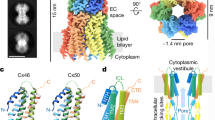Summary
The Junctional complex of choroid epithelial cells was studied during in vivo formation, disaggregation after trypsin treatment, and in vitro reaggregation. The in vivo formation begins with the occurrence of amorphous patches of particles followed by the formation of small particulate rows and polygonal-ordered particle assemblies. Further arrangement of the zonula occludens continues with the confluence of particles and smooth contoured ridges. At the 9th day stage a fully developed zonula occludens has developed. In a subsequent step nexus become integrated within the tight junction formation. Disaggregation after trypsination results in fragmentation of the zonulae occludentes. Parts of the disassembling aggregates become incorporated in vacuoles indicating an endocytotic mode of “digestion”. The in vitro reconstruction of the zonula occludens proceeds from remnants of the former zonula occludens. On the 3rd to 4th day of cultivation mature tight junctions are visible. In vitro integrations of nexus were observed during a later phase. On the 7th day, cultivated choroid epithelial cells reveal well differentiated Junctional complexes consisting of continuous zonulae occludentes and integrated gap junctions.
Similar content being viewed by others
References
Albertini, D.F., Anderson, E.: The appearance and structure of intercellular connections during the ontogeny of the rabbit ovarian follicle with particular reference to gap junctions. J. Cell Biol. 63, 234–250 (1974)
Brightman, M.W., Prescott, L., Reese, T.S.: Intercellular junctions in specialized ependyma. In: Second Int. Symp. on Brain-Endocrine-Interaction (K.M. Knigge, D.E. Scott, H. Kobayashi, S. Ishii, eds.), pp. 146–165. Basel: S. Karger 1975
Claude, P., Goodenough, D.A.: Fracture faces of zonulae occludentes from “tight” and “leaky” epithelia. J. Cell Biol. 58, 390–400 (1973)
Decker, R.S.: Influence of thyroxine of anuran gap junctions. J. Cell Biol. 67, 89a (1975)
Decker, R.S.: Hormonal regulation of gap junction differentiation. J. Cell Biol. 69, 669–685 (1976)
Decker, R.S., Friend, D.S.: Assembly of gap junctions during amphibian neurulation. J. Cell Biol. 62, 32–47 (1974)
Dermietzel, R.: Die Darstellung eines komplexen Systems endothelialer und perivaskulärer Membrankontakte im Plexus chorioideus. Verh. anat. Ges. 70, 461–469 (1976)
Dermietzel, R., Anghileri, L.J., Schünke, D.: Visualization of junctions in sinusoidal endothelia of Cholangiocarcinoma of rats by use of a goniometer stage. Experientia (Basel) (submitted for publication)
Elias, P.M., Friend, D.S.: Vitamin-A-induced mucous metaplasia: an in vitro system for modulating tight and gap junction differentiation. J. Cell Biol. 68, 173–188 (1976)
Gilula, N.B.: Isolation of rat liver gap junctions and characterization of the polypeptides. J. Cell Biol. 63, 111 a (1974)
Gilula, N.B., Fawcett, D.W., Aoki, A.: The Sertoli cell occluding junctions and gap junctions in mature and developing mammalian testis. Develop. Biol. 50, 142–168 (1976)
Goodenough, D.A.: Bulk isolation of mouse hepatocyte gap junctions. J. Cell Biol. 61, 557–563 (1974)
Goodenough, D.A., Caspar, D.L.D., Makowski, L., Philips, W.C.: X-ray diffraction of isolated gap junctions. J. Cell Biol. 63, 115a (1974)
Goodenough, D.A., Revel, J.-P.: The permeability of isolated and in situ mouse hepatic gap junctions studied with enzymatic tracers. J. Cell Biol. 50, 81–91 (1971)
Goodenough, D.A., Stoeckenius, W.: The isolation of mouse hepatocyte gap junctions. Preliminary chemical characterization and x-ray diffraction. J. Cell Biol. 54, 646–656 (1972)
Johnson, R., Hammer, M., Sheridan, J., Revel, J.-P.: Gap junction formation between reaggregated Nowikoff hepatoma cells. Proc. nat. Acad. Sci. (Wash.) 71, 4536–4540 (1974)
McNutt, N.S., Weinstein, R.S.: Membrane ultrastructure of mammalian intercellular junctions. Progr. Biophys. molec. Biol. 26, 45–101 (1973)
Meller, K., Wagner, H.H.: Die Feinstruktur des Plexus chorioideus in Gewebekulturen. Z. Zellforsch. 86, 98–110 (1968)
Meller, K., Wagner, H.H., Breipohl, W.: Das Verhalten trypsinierter Plexus chorioideus-Zellen in Gewebekulturen. Eine elektronenmikroskopische Untersuchung. Z. Zellforsch. 97, 392–402 (1969)
Meller, K., Wechsler, W.: Elektronenmikroskopische Untersuchung der Entwicklung der telencephalen Plexus chorioides des Huhnes. Z. Zellforsch. 65, 420–444 (1965)
Montesano, R.: Junctions between sinusoidal endothelial cells in fetal rat liver. Amer. J. Anat. 144, 387–391 (1975)
Montesano, R., Friend, D.S., Perrelet, A., Orci, L.: In vivo assembly of tight junctions in fetal rat liver. J. Cell Biol. 67, 310–319 (1975)
Revel, J.P., Brown, S.S.: Cell junctions in development, with particular reference to the neural tube. Cold Spring Harbor Symposium on Quantitative Biology 40, 443–455 (1976)
Revel, J.P., Yip, P., Chang, L.L.: Cell junctions in the early chick embryo — a freeze etch study. Develop. Biol. 35, 302–317 (1973)
Simionescu, M., Simionescu, N., Palade, G.E.: Segmental differentiations of cell junctions in the vascular endothelium. The microvasculature. J. Cell Biol. 67, 863–885 (1975)
Staehelin, L.A.: Further observations on the fine structure of freeze-cleaved tight junctions. J. Cell Sci. 13, 763–786 (1973)
Staehelin, L.A.: Structure and function of intercellular junctions. Int. Rev. Cytol. 39, 191–283 (1974)
Yee, A.G.: Gap junctions between hepatocytes in regenerating rat liver. J. Cell Biol. 55, 294a (1972)
Yee, A.G., Revel, J.P.: Endothelial cell junctions. J. Cell Biol. 66, 200–204 (1975)
Author information
Authors and Affiliations
Additional information
Supported by a grant to R. Dermietzel (SFB 114 Bionach) and a grant to K. Meller (Me 276/7) from the Deutsche Forschungsgemeinschaft. We thank Mrs. Ursula Lietz for her help with the English translation and Mrs. C. Bloch for typing the manuscript
Rights and permissions
About this article
Cite this article
Dermietzel, R., Meller, K., Tetzlaff, W. et al. In vivo and in vitro formation of the junctional complex in choroid epithelium. Cell Tissue Res. 181, 427–441 (1977). https://doi.org/10.1007/BF00221766
Accepted:
Issue Date:
DOI: https://doi.org/10.1007/BF00221766




